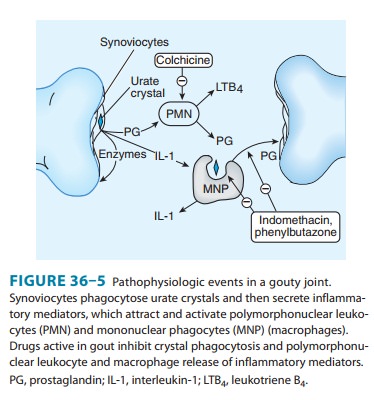Chapter: Basic & Clinical Pharmacology : Nonsteroidal Anti-Inflammatory Drugs, Disease-Modifying Antirheumatic Drugs, Nonopioid Analgesics,& Drugs Used in Gout
Drugs Used In Gout
DRUGS USED IN GOUT
Gout is a metabolic
disease characterized by recurrent episodes of acute arthritis due to deposits
of monosodium urate in joints and cartilage. Uric acid renal calculi, tophi,
and interstitial nephritis may also occur. Gout is usually associated with a
high serum uric acid level (hyperuricemia), a poorly soluble substance that is
the major end product of purine metabolism. In most mammals, uricase converts
uric acid to the more soluble allantoin; this enzyme is absent in humans. While
clinical gouty episodes are associated with hyperuricemia, most individuals
with hyperuricemia may never develop a clinical event from urate crystal
deposition.
The treatment of gout
aims to relieve acute gouty attacks and prevent recurrent gouty episodes and
urate lithiasis. Therapies for acute gout are based on our current
understanding of the pathophysiologic events that occur in this disease (Figure
36–5). Urate crystals are initially phagocytosed by synoviocytes, which then
release prostaglandins, lysosomal enzymes, and interleukin-1. Attracted by
these chemotactic mediators, polymorphonuclear leukocytes migrate into the
joint space and amplify the ongoing inflammatory process. In the later phases
of the attack, increased numbers of mononuclear phagocytes (macrophages)
appear, ingest the urate crystals, and release more inflammatory mediators.
This sequence of events suggests that the most effective agents for the
management of acute urate crystal-induced inflammation are those that suppress
different phases of leukocyte activation.

Before starting
chronic urate-lowering therapy for gout, patients in whom hyperuricemia is
associated with gout and urate lithiasis must be clearly distinguished from
individuals with only hyperuricemia. The efficacy of long-term drug treatment
in an asymptomatic hyperuricemic person is unproved. In some indi-viduals, uric
acid levels may be elevated up to 2 standard deviations
Many different agents
have been used for the treatment of acute and chronic gout. However,
non-adherence to these drugs is exceed-ingly common; adherence has been
documented to be as low as 26–18%, especially in younger patients. Providers
should be aware of compliance as an important issue.
Related Topics